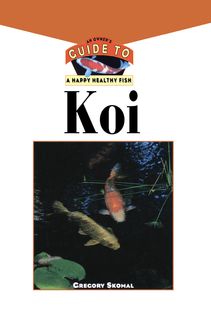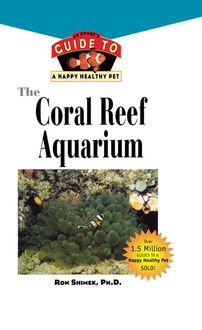The Coral Reef Aquarium , livre ebook
89
pages
English
Ebooks
2007
Vous pourrez modifier la taille du texte de cet ouvrage
Obtenez un accès à la bibliothèque pour le consulter en ligne En savoir plus
Découvre YouScribe et accède à tout notre catalogue !
Découvre YouScribe et accède à tout notre catalogue !
89
pages
English
Ebooks
2007
Vous pourrez modifier la taille du texte de cet ouvrage
Obtenez un accès à la bibliothèque pour le consulter en ligne En savoir plus
Publié par
Date de parution
31 août 2007
Nombre de lectures
4
EAN13
9780470252758
Langue
English
Poids de l'ouvrage
1 Mo
PART ONE: Understanding the Coral Reef.
1. An Artificial Ecosystem.
2. Chemical Considerations.
3. Material and Energy Flow.
PART TWO: The Environment.
4. Necessary Equipment.
5. Your Reef System.
PART THREE: The Organisms.
6. Invertebrates in Your Aquarium.
7. Fishes and Algae in Your Aquarium.
PART FOUR: Beyond the Basics.
8. Recommended Reading and Resources.
Publié par
Date de parution
31 août 2007
EAN13
9780470252758
Langue
English
Poids de l'ouvrage
1 Mo
The
Coral Reef Aquarium
Howell Book House
Howell Book House
A Pearson Education Macmillan Company
1633 Broadway
New York, NY 10019
Macmillan Publishing books may be purchased for business or sales promotional use. For information, please write to: Special Markets Department, Macmillan Publishing USA, 1633 Broadway, New York, NY 10019.
Copyright 1999 by Howell Book House
Copyright 1999 All photography by Scott W. Michael and Janine Carnes-Michael
All rights reserved. No part of this book may be reproduced or transmitted in any form or by any means electronic or mechanical, including photocopying, recording, or by any information storage or retrieval system, without permission in writing from the publisher.
MACMILLAN is a registered trademark of Macmillan, Inc.
ISBN: 1-58245-117-6
Library of Congress Cataloging-in-Publication Data
Shimek, Ron L.
The coral reef aquarium: an owner s guide to a happy healthy fish / [Ron L. Shimek].
p. cm.
Includes bibliographical references (p. ).
1. Marine Aquariums. 2. Coral reef animals. I. Title.
SF457.1.S545 1999
639.34 2-dc21 99-25667
CIP
Manufactured in the United States of America
10 9 8 7 6 5 4 3 2 1
Series Director: Amanda Pisani
Book Design: Michele Laseau
Cover Design: Iris Jeromnimon
Illustration: Ron Shimek, Ph.D.
Photography: Scott W. Michael and Janine Cairnes-Michael
Production Team: Carrie Allen, Oliver Jackson, Faunette Johnston, Clint Lahnen, Dennis Sheehan, Terri Sheehan
Contents
part one
Understanding the Coral Reef
1 An Artificial Ecosystem
2 Chemical Considerations
3 Material and Energy Flow
part two
The Environment
4 Necessary Equipment
5 Your Reef System
part three
The Organisms
6 Invertebrates in Your Aquarium
7 Fishes and Algae in Your Aquarium
part four
Beyond the Basics
8 Recommended Reading and Resources
part one
Understanding the Coral Reef
chapter 1
An Artificial Ecosystem
So you want to set up a reef aquarium. Well, you are not alone. The beauty and diversity of the coral reefs have captivated people for a long time. Setting up a marine reef aquarium is not particularly hard. After all, you just need some animals, a tank, some salt water and presto! You have created a marine reef aquarium. Keeping your animals healthy, however, is a bit more involved. There are numerous ways to successfully establish a marine reef aquarium, although many of these methods are exceptionally technically complex. Such complex methods, however, are no more successful than a more basic approach that deals with the organisms and the system as if they were components of an ecosystem as, indeed, they are. I will follow the basic approach in this book. It is an approach that works, and it is relatively inexpensive. It has the further advantage of producing a resilient system that is easy to maintain.
A Bit of Necessary Biology
An ecosystem consists of a physical environment, organisms and definite and repeatable pathways for energy and material transfer. We refer to these pathways as food chains or food webs. In recognizing that animals must feed, we are recognizing the fundamental biological truth of the necessity of energy and material transfer. Organisms eat to obtain energy for their metabolic pathways and to obtain materials to build or repair tissues. For the vast majority of organisms, this energy source is the sun. Organisms that can use the sun to power their synthetic machinery are plants, algae and photosynthetic bacteria called cyanobacteria, or blue-green algae.
These organisms capture the energy in sunlight using a special pigment (chlorophyll), and they use this energy to combine carbon dioxide (CO 2 ) and water (H 2 O) molecules into a sugar called glucose. This process is known as photosynthesis. Oxygen gas, O 2 is given off as a byproduct of this reaction. Later, to power other cellular processes, this sugar can be slowly broken back down to its constituent carbon dioxide and water molecules, and the stored energy in it can be recovered. This process is called respiration, and it uses oxygen to burn the sugar.
Organisms are not very efficient at utilizing the food they eat. As a rule, only about 10-20 percent of the eaten food is converted into animal tissue. The rest is lost as waste, undigested food, respiration byproducts or waste energy (heat). The moral for the reef aquarist is that animals need to feed, and because the animals are inefficient at utilizing food, they must be fed a lot to remain in good health.
In maintaining a mini-reef aquarium as an artificial ecosystem, the movement of all this material and chemical energy through the various ecological systems is facilitated. This in turn facilitates the stability of the system and the final removal of excess products from the system.
This might sound complicated and complex, but in practice, it is easy to construct and even easier to maintain. These artificial ecosystems are designed to allow you to sit back and enjoy the system without worrying about constant adjustments and maintenance. Most aquarists can maintain such a system with as little as a few easily scheduled hours of care per week.
All organisms, corals included, need nutrition. As a hobbyist, one of your jobs is to feed your coral .
Natural Versus Artificial Habitats
To be a fully functional ecosystem, your captive reef must contain analogues of all the components of natural reef ecosystems. There are two significantly different types of components in our systems: the water and the substrate. The water, not surprisingly, consists of the fluid water medium with its dissolved and suspended solids and the organisms found in it. These organisms may be rather arbitrarily defined as swimming or planktonic organisms. Swimming organisms are organisms that are able to move significant distances against water currents using their own locomotion. Generally, we place most fishes, squid, marine mammals and some of the larger swimming crustaceans and snails in this category. Planktonic organisms are organisms that are pretty much at the whim of the water currents, although they might be able to swim some rather considerable distances, particularly in relation to their body size. These are rather sloppy definitions (broadly based on size), but they work pretty well in most cases.
ANIMALS NOT MEANT FOR THE HOME AQUARIUM
Note that truly mid-water or pelagic species, whether fish or invertebrates, are effectively impossible to keep in tanks smaller than 1,000 gallons. So if your heart is set on maintaining a pelagic shark, jack or jellyfish, you had best find a job as an aquarium technician at a large commercial aquarium and give those urges an outlet there. Such animals have no place in the typical home aquarium because you simply cannot provide conditions for even short-term survival of most of these species.
Water in Nature Versus Water in the Artificial System
The water environment in your artificial system is the most abnormal of all the environments in captive ecosystems. This is primarily because it is severely limited in size relative to the hard substrate in the tank. Much of the food and raw materials necessary in a natural coral reef are brought to the reef through the action of water currents. Relative to the size of the reef at any place and time, the volume of the ocean is immense and contains an effectively unlimited supply of food and raw chemical materials. In nature, such materials are never depleted because they are renewed, literally, with the next wave.
Fish that dwell near the reef are known as epibenthic animals (Spot lionfish , Pterois antennata).
The very small volume of water in even the largest of our systems comprises only a very small fraction of the amount of water passing over the same amount of reef substrate in nature. This means that our systems can become rapidly and seriously depleted in both materials and food. Because neither of these conditions typically is encountered in nature, the animals have no contingency behavioral responses to the conditions of insufficient food and dissolved essential chemicals. Monitoring and maintaining these materials is the major duty necessary to maintain a healthy artificial ecosystem.
The water environment is important for another reason, of course. It is the home of many of the fish species we keep in our systems. Maintenance of the appropriate water conditions is critical for the well-being of these animals.
A NIMALS L IVING N EAR THE R EEF
Most of our fishes fall into the category of epibenthic animals. These animals are found near the hard reef substrate but not on it. Under normal conditions in the real world, they might be found as far from the reef as a few meters, but they are not really ever found in mid-water. At night, most of these individuals find shelter in a hole or nook in the reef and huddle up to pass the night in safety.
A NIMALS L IVING ON THE S UBSTRATE
Organisms that live on or in the substrates are referred to as benthic organisms. Benthic organisms live on or in the bottoms of bodies of water. The animals that live on the surface of the substrate are referred to as epifaunal organisms or epifauna. The epifauna can be mobile such as crabs or sea anemones, or they can be immobile such as corals. Many epifaunal animal species make good aquarium inhabitants, and a few of them are necessary to maintain a healthy tank. Epifaunal hermit crabs, for example, are mostly scavengers and help keep the tank clean of uneaten food. In addition, many of the epifaunal gastropods are exceptionally good grazers on microalgae and are useful in helping keep the sides of the tank clean.
Corals live on the substrate s surface and are known as epifaunal animals .
A NIMALS L IVING IN THE S UBSTRATE
Organisms that live in the substrates are known as infauna. The infauna can be found in either rocks or sediments. The majority of the living tissue found in natural sy







